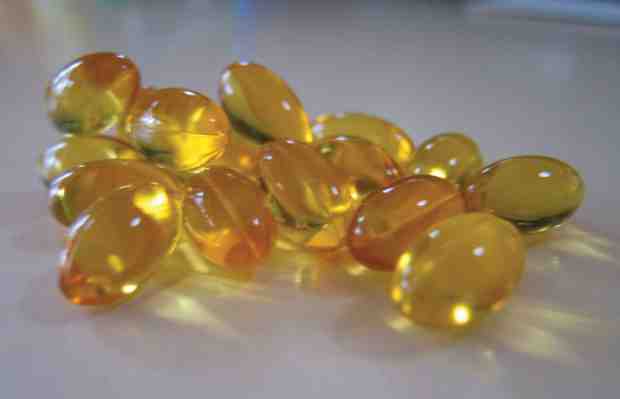Fish Oil: Supplement or Drug or Worthless?
The usefulness of taking over the counter fish oil supplements and now prescription fish oil medications to prevent cardiovascular disease and events like heart attack and stroke has had poor support from medical experts because previous studies have showed minimal to no benefit. However in the past two years, we have learned more including who can be helped from fish oil and what kind should be taken.

First, only a certain type of fish oil called “Omega 3” is effective. It has been used in the past in moderate doses to bring down triglycerides in people who are already taking cholesterol lowering drugs (statins) and has been available over the counter and is now available in higher doses by prescription. Over the past 2 years three studies have established that in people who have high triglycerides (>150mg%) and are taking Omega 3 along with a cholesterol lowering medications, they achieve lower triglyceride levels and enjoy a reduced chance of heart attack and death from heart disease. Surprisingly, Omega 3 in these doses (1 gram per day) does not reduce the risk of stroke and has a weaker effect in people who do not have established cardiovascular disease as opposed to someone who has known disease of the arteries of their heart. However, it is now clear that even if you do not have cardiovascular disease, taking an Omega 3 capsule of 1 gram per day can reduce the risk of death from cardiovascular disease PROVIDED your intake of fish is less than 1.5 servings per week. If you eat 1.5 servings of fish per week or more, there is NO benefit in taking 1 gram/day of Omega 3.
Interestingly, the average dietary intake of Omega 3 in the United States is only 100mg per day which is 1/5th the recommended minimal daily amount of Omega 3 in an ideal diet and 1/10th the amount in a typical one gram capsule of Omega 3. In other words, the US diet is quite deficient in Omega 3 or “fish oil”. The best sources of Omega 3 are oily fish such as salmon, herring, anchovies, sardines and rainbow trout. White fish such as tilapia have much lower content. And to get the benefit of Omega 3 without taking a pill, at least 1.5 servings of fish per week are required.
Finally, a new prescription Omega 3 drug is available called “Vascepa” which has 4 grams of concentrated fish oil per tablet. In people already on a statin medication with known cardiovascular disease plus elevated triglycerides, taking 4 grams of this fish oil preparation daily has recently been shown to reduce triglycerides, cardiovascular death, heart attack and stroke by 28% compared to placebo. But, it would be nearly impossible to take this much Omega 3 in one’s diet. Accordingly, this new preparation of Omega 3 is likely going to be prescribed for a substantial number of people with known cardiovascular disease and elevated triglycerides who already are taking a statin drug. Its also reassuring that there are minimal to no side effects with all of these Omega 3 preparations.
In summary fish oil supplements and now concentrated prescription preparations seem to have the ability to reduce the risk of death from cardiovascular disease beyond what the cholesterol lowering (statin) group of medicines can achieve. Yet, for the standard over the counter Omega 3 supplement (1 gram tablet) the cardiovascular benefit, albeit modest, is seen only if dietary Omega 3 is deficient. Use of the more concentrated form, Vascepa, should be limited to those with both cardiovascular disease and elevated triglycerides who are already on statin medications.
Omega-3 Fish Oil and Pregnancy
Why is Omega-3 Fish Oil Important During Pregnancy?

Adequate intake of Omega-3 fats is essential to maintaining the balanced production of the hormone-like substances called prostaglandins. Prostaglandins help regulate many important physiological functions including blood pressure, blood clotting, nerve transmission, the inflammatory and allergic responses, the functions of the kidneys and gastrointestinal tract and the production of other hormones.
Depending on the type of fatty acids in the diet, certain types of prostaglandins may be produced in large quantities, while others may not be produced at all. This prostaglandin imbalance can lead to disease. The role of omega-3s in producing beneficial prostaglandins may explain why they have been shown to have so many health benefits, including the prevention of heart disease, improving cognitive function and the regulation of inflammation.
High doses of omega-3s have been used to treat and prevent mood disorders, and new studies are identifying their potential benefits for a wide range of conditions including cancer, inflammatory bowel disease and other autoimmune diseases such as lupus and rheumatoid arthritis.
Scientific research is constantly expanding our knowledge of nutritional needs in pregnancy. Among the most recent developments in this field is the importance of Omega-3 Fatty Acids in both the development of a healthy baby and in the health of the mother.
Omega-3 Fish Oil Benefits & Dosage
Omega-3s are a family of long-chain polyunsaturated fatty acids that are essential nutrients for health and development. Unfortunately, these are not synthesized by the human body and therefore must be obtained from diet or supplementation.
However, the typical American diet is greatly lacking in Omega-3’s. Research indicates that the two most beneficial omega-3s are EPA (eicosapentaenoic acid) and DHA (docosahexaenoic acid). Although EPA and DHA naturally occur together and work together in the body, studies show that each fatty acid has unique benefits.
EPA supports the heart, immune system, and inflammatory response. DHA supports the brain, eyes, and central nervous system, which is why it is uniquely important for pregnant and lactating women.
The Benefits of Omega-3 Fish Oil
Omega-3s have been found to be essential for both neurological and early visual development of the baby. However, the standard western diet is severely deficient in these critical nutrients. This omega-3 dietary deficiency is compounded by the fact that pregnant women become depleted in omega-3s because the fetus uses omega-3s for its nervous system development.
Omega-3s are also used after birth to make breast milk. With each subsequent pregnancy, mothers are further depleted. Research has confirmed that adding EPA and DHA to the diet of pregnant women has a positive effect on visual and cognitive development of the baby. Studies have also shown that higher consumption of omega-3s may reduce the risk of allergies in infants.
Omega-3 fatty acids have positive effects on the pregnancy itself. Increased intake of EPA and DHA has been shown to prevent pre-term labor and delivery, lower the risk of preeclampsia, and may increase birth weight. Omega-3 deficiency also increases the mother’s risk of depression. This may explain why postpartum mood disorders may become worse and begin earlier with subsequent pregnancies.
Which Foods Contain Omega-3 Fish Oil?
The best sources of EPA and DHA are cold-water fish such as salmon, tuna, sardines, anchovies, and herring. Many people are justifiably concerned about mercury and other toxins in fish, especially during pregnancy. For this reason, purified fish oil supplements are often the safest source of EPA and DHA. A high-quality fish oil supplement from a reputable manufacturer like Nordic Naturals delivers the health benefits of EPA and DHA without the risk of toxicity.
Many people think that flaxseed or flaxseed oil contains omega-3s. But flaxseed contains the shorter-chain omega-3, ALA (alpha-linolenic acid), which is different from the longer-chain EPA and DHA. EPA and DHA are the Omega-3s that the body needs for optimal health and development. While it was once thought that the human body could convert ALA to EPA and DHA, current research shows that such conversion rarely and inefficiently occurs. Fish oil is a more reliable source of EPA and DHA.
Safety Considerations
Quality fish oil is safe to take during pregnancy. Fresh fish can often contain environmental toxins like mercury that accumulate during its life span. These toxins can be virtually eliminated during the manufacture and processing of fish oil, with the use of high-quality raw materials and an advanced refining process.
Some brands of fish oil are of higher quality than others. A reputable fish oil manufacturer should be able to provide documentation of third-party lab results that show the purity levels of their fish oil, down to the particles per trillion level.
Fish Oil Recommendations
Investigate the manufacturing process– How is the fish oil manufactured and what are the quality standards that the manufacturer is using? The quality standards that exist for fish oil-including the Norwegian Medicinal Standard, the European Pharmacopoeia Standard and the voluntary U.S. standard established by the Council for Responsible Nutrition’s 2006 monograph-guarantee quality by setting maximum allowances for toxins.
How is the fish oil manufactured and what are the quality standards that the manufacturer is using? The quality standards that exist for fish oil-including the Norwegian Medicinal Standard, the European Pharmacopoeia Standard and the voluntary U.S. standard established by the Council for Responsible Nutrition’s 2006 monograph-guarantee quality by setting maximum allowances for toxins. Smell– Does the fish oil smell fishy? Research shows that fish oils only smell unpleasant when the oil has started to degrade and is becoming rancid. A high-quality fish oil supplement will not smell fishy.
Does the fish oil smell fishy? Research shows that fish oils only smell unpleasant when the oil has started to degrade and is becoming rancid. A high-quality fish oil supplement will not smell fishy. Taste– Does the fish oil taste fishy? The freshest and highest-quality fish oils should not taste fishy. Avoid fish oils that have really strong or artificial flavors added to them because they are most likely trying to hide the fishy flavor of rancid oil.
Dosage Recommendations
ISSFAL (the International Society for the Study of Fatty Acids and Lipids) has established the following recommended minimum dosage chart:
Infants (1-18 months):
0-15 lbs: 32 mg/lb EPA+DHA
Children (1.5-15 yrs):
15 mg/lb EPA+DHA
Adults (15-115 yrs):
500 mg EPA+DHA (with a minimum of 220 mg EPA and 220 mg DHA)
Pregnant and Lactating Women:
300 mg DHA daily
Compiled using information from the following sources:
1. Measurement of organochlorines in commercial over-the-counter fish oil preparations: implications for dietary and therapeutic recommendations for omega-3 fatty acids and a review of the literature. Melanson SF, et al. Arch Pathol Lab Med 2005;129:74-77.
2. Measurement of mercury levels in concentrated over-the-counter fish oil preparations: is fish oil healthier than fish? Foran SE, et al. Arch Pathol Lab Med 2003;127:1603-1605.
3. International Society of the Study of Fatty Acids and Lipids (ISSFAL)
cod-liver oil
cod-liver oil, pale yellow oil obtained primarily from the liver of the Atlantic cod, Gadus morhua, and other species of the family Gadidae. Cod-liver oil is a source of vitamins A and D. It was widely used in the 18th, 19th, and early 20th centuries to treat and prevent rickets, a disease characterized by defective bone growth that is caused by a lack of vitamin D. Widespread fortification of milk with vitamin D in the United States and Europe beginning in the 1930s eliminated rickets as a significant public health problem, and with that physicians stopped recommending the use of cod-liver oil. It is still sold in health food stores as a vitamin supplement, as a remedy for joint pain caused by arthritis, and as a preventive of cardiovascular disease—although these last benefits have not been proved scientifically. Cod-liver oil is also used in feeds for poultry and other animals.

Chemically, cod-liver oil is a typical fish oil. It is high in omega-3 fatty acids, a valuable aspect in nutrition but one that makes it subject to oxidation, rancidification, and destruction of vitamin A when it is exposed to air. Cod-liver oil is a mixture of glycerides of many fatty acids, predominantly oleic acid, gadoleic acid, and palmitoleic acid. Both vitamin A and vitamin D toxicity can result from the consumption of large amounts of cod-liver oil.
The chief countries producing cod-liver oil are Norway, Japan, Iceland, and Poland. Fresh cod livers are digested by steam, water, acid, or alkali to produce the oil. Medicinal grades are chilled, and congealed stearic acid and other fatty acids are filtered off.

